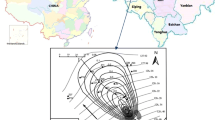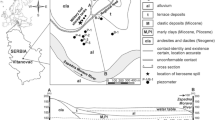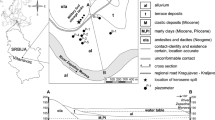Abstract
The objective of this study was to investigate a petroleum-contaminated groundwater site in northeast China. We determined the physicochemical properties of groundwater that contained total petroleum hydrocarbons (TPH) with a view to developing a scientifically robust strategy for controlling and remediating pollution of groundwater already contaminated with petroleum. Samples were collected at regular intervals and were analyzed for dissolved oxygen (DO), iron (Fe3+), sulfate (SO42−), electrical conductivity (Eh), pH, hydrogen carbonate (HCO3−), and enzyme activities of catalase (CAT), peroxidase (HRP), catechol 1,2-dioxygenase (C12O), and catechol 2,3-dioxygenase (C23O). We used factor analysis in SPSS to determine the main environmental characteristics of the groundwater samples. The results confirmed that the study site was slightly contaminated and that TPH levels were decreasing slightly. Some of the physicochemical variables showed regular fluctuations; DO, Fe3+, and SO42− contents decreased gradually, while the concentrations of one of the microbial degradation products, HCO3−, increased. Microorganism enzyme activities decreased gradually. The microbiological community deteriorated noticeably during the natural attenuation process, so microbiological degradation of pollutants receded gradually. The HCO3− content increased and the pH and Eh decreased gradually. The groundwater environment tended to be reducing.







Similar content being viewed by others
References
A. Konoplev V, Golosov Y, Wakiyama T, et al. (2017). Natural attenuation of Fukushima-derived radiocesium in soils due to its vertical and lateral migration. Journal of Environmental Radioactivity,1–11.
Aleksandra, K., Ewa, K., Monika, C., & Grzegorz, M. (2013). Assessment of intrinsic biodegradation potentials in an aquifer contaminated with chlorinated ethenes in the vicinity of Nowa Deba. Ecological Chemistry and Engineering S, 20(2), 265–278.
Alvarez, V. M., Marques, J. M., Korenblum, E., Seldin, L., & Li, W. J. (2011). Comparative bioremediation of crude oil-amended tropical soil microcosms by natural attenuation, bioaugmentation, or bioenrichment. Applied and Environmental Soil Science, 2011, 1–10. https://doi.org/10.1155/2011/156320
Blum, P., Sagner, A., Tiehm, A., Martus, P., Wendel, T., & Grathwohl, P. (2011). Importance of heterocylic aromatic compounds in monitored natural attenuation for coal tar contaminated aquifers: a review. Journal of Contaminant Hydrology, 126(3–4), 181–194. https://doi.org/10.1016/j.jconhyd.2011.08.004
Chen, K. F., Kao, C. M., & Chen, C. W. (2010). Control of petroleum hydrocarbon contaminated groundwater by intrinsic and enhanced bioremediation. Journal of Environmental Sciences, 22(6), 864–871. https://doi.org/10.1016/S1001-0742(09)60190-X
Corseuil, H. X., Monier Amy, L., Marilda, F., et al. (2011). BTEX plume dynamics following an ethanol blend release: geochemical footprint and thermodynamic constraints on natural attenuation. Environmental Science & Technology, 45(8), 3422–3429. https://doi.org/10.1021/es104055q
Cozzarelli I M, Bekins B A, Eganhouse R P, Warren E, Essaid H I(2010). In situ measurements of volatile aromatic hydrocarbon biodegradation rates in groundwater. Journal of Contaminant Hydrology, 111(1–4): 48–64, 1-4, DOI: https://doi.org/10.1016/j.jconhyd.2009.12.001.
Fan, W., Yang, Y. S., Du, X. Q., Lu, Y., & Yang, M. X. (2011). Finger-printing biodegradation of petroleum contamination in shallow groundwater and soil system using hydro-bio-geochemical markers and modelling support. Water, Air, and Soil Pollution, 220(1-4), 253–263. https://doi.org/10.1007/s11270-011-0751-7
Grant, A., Kappelman, M., Martin, C., & Otley, A. (2016). O-021 a new domain structure for the IMPACT-III, a pediatric inflammatory bowel disease (IBD) health reported quality of life (HRQOL) tool. Inflammatory Bowel Diseases, 22(Suppl 1), S7–S8. https://doi.org/10.1097/01.MIB.0000480111.27190.df
Han, Z. Y., Wei, X. B., & WB, D. (2014). Iron filings as PRB media regression analysis of remediation of chromium-contaminated groundwater. Advanced Materials Research, 2914(864), 1178–1182.
Huang, L. H., Liu, G. F., Dong, G. H., Wu, X. Y., Wang, C., & Liu, Y. Y. (2017). Reaction mechanism of zero-valent iron coupling with microbe to degrade tetracycline in permeable reactive barrier (PRB). Chemical Engineering Journal, 316, 525–533. https://doi.org/10.1016/j.cej.2017.01.096
Janey, V., Mark, D., & Eugene, J. (2010). Inland waterway resource and spill management needs in Southeastern USA. Diseaster Prevention and Management, 19(4), 483–497.
Lee, J. Y. (2011). Environmental issues of groundwater in Korea: implications for sustainable use. Environmental Conservation, 38(1), 64–74. https://doi.org/10.1017/S0376892911000087
Liang, S. H., Kao, C. M., & Kuo, Y. C. (2011). In situ oxidation of petroleum hydrocarbon contaminated groundwater by using passive ISCO system. Water Res, 45(8), 2496–2506. https://doi.org/10.1016/j.watres.2011.02.005
Li, L., Wray, H. E., Andrews, R. C., & Bérubé, P. R. (2014). Ultrafiltration fouling: impact of backwash frequency and air sparging. Separation Science and Technology, 49(18), 2814–2823. https://doi.org/10.1080/01496395.2014.948964
Lin, F., Liu, P. G., Wei, T., Ren, H. L., Wu, D., & Tao, Y. Z. (2017). Contamination prediction and control of landfills to groundwater in coalmine subsidence area. Energy Procedia, 107, 217–221. https://doi.org/10.1016/j.egypro.2016.12.130
Lu, M., Zhang, Z. Z., Qiao, W., Wei, X. F., Guan, Y. M., Maa, Q. X., & Guan, Y. C. (2010). Remediation of petroleum-contaminated soil after composting by sequential treatment with Fenton-like oxidation and biodegradation. Bioresource Technology, 101(7), 2106–2113. https://doi.org/10.1016/j.biortech.2009.11.002
Lv, H., Liu, M. Y., XS, S., & Lin, G. Y. (2013). Determination of biogeochemical processes in oil-contaminated aquifer using principal component analysis. Journal of Central South University (Science and Technology), 44(8), 3552–3560.
Mohammadi, H., Noroozi, M., & Eftekhari, M. (2013). Techno-economic review on storage of petroleum products in abandoned underground salt mines: a case study on underground salt mines of Sardareh region, Garmsar, Iran. International Journal of Mining Science and Technology, 23(06), 931–936. https://doi.org/10.1016/j.ijmst.2013.11.009
Nathaniel, M. R., Kanokporn, C., & Khuanchai, S. (2016). Better antiretroviral central nervous system penetration is not associated with reduced chronic pain in people living with human immunodeficiency virus. Anti-Infective Agents, 14(1), 38–46.
Pan, F., Chen, L. H., SJ, F., Liang, J. N., & Ma, J. Z. (2012). A study on the transport performance of the petroleum contaminants in soil of the Longdong loess plateau. Acta Scientiae Circumstantiae, 32, 410–418.
Ravi, N., Nandy, S., Megharaj, M., Kumar, R. P., Chadalavada, S., Chen, Z., & Bowman, M. (2012). Monitored natural attenuation of a long-term petroleum hydrocarbon contaminated sites: a case study. Biodegradation, 23(6), 881–895. https://doi.org/10.1007/s10532-012-9580-7
Su, X. S., & Wang, W. (2012). The research of petroleum contaminated site media for adsorption of petroleum pollutant. Advanced Materials Research, 2, 393–395.
Tfincsics, A., Szabo, I., & Bake, E. (2010). Investigation of Cateehol 2, 3-dioxygenase and 1 6S rRNA gene diversity in hypoxic, petroleum hydrocarbon contaminated groundwater. Systematic and Applied Microbiology., 33(7), 398–406. https://doi.org/10.1016/j.syapm.2010.08.005
Wona, Z., Grzegorz, M., Wojciech, C., & Piotr, R. (2014). Effectiveness of intrinsic biodegradation enhancement in oil hydrocarbons contaminated soil. Archives of Environmental Protection, 40(1), 101–113.
Zhang, Y., Zhang, Y. L., Zhang, S. Y., Song, F., Huang, J. Y., Zhang, Y., & Bai, X. D. (2012). Utilization of scoria as PRB reactive media for the removal of petroleum hydrocarbon from groundwater. Advanced Materials Research, 1896(535), 2457–2461.
Zhang, Z. N., Zhou, Q. X., Peng, S. W., & Cai, Z. (2010). Remediation of petroleum contaminated soils by joint action of Pharbitis nil L. and its microbial community. Sci Total Environ, 408, 5600–5605.
Funding
This study was supported by National Natural Science Foundation of China (Grant No. 41203050) and Natural Foundation of Jilin Province(Grant No.Natural Science Foundation of China).
Author information
Authors and Affiliations
Corresponding author
Rights and permissions
About this article
Cite this article
Qian, H., Zhang, Y., Wang, J. et al. Characteristics of petroleum-contaminated groundwater during natural attenuation: a case study in northeast China. Environ Monit Assess 190, 80 (2018). https://doi.org/10.1007/s10661-017-6449-6
Received:
Accepted:
Published:
DOI: https://doi.org/10.1007/s10661-017-6449-6




